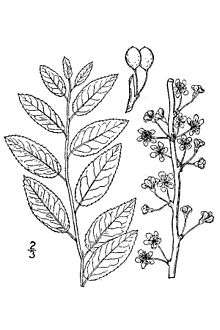Prunus gracilis
Prunus gracilis, called the Oklahoma plum,[2][3] sour plum, and sand plum, is native to the south-central United States (eastern New Mexico, southeastern Colorado, Texas, Oklahoma, Kansas, southwestern Arkansas, northwestern Louisiana).[4][5]
| Prunus gracilis | |
|---|---|
 | |
| 1913 illustration[1] | |
| Scientific classification | |
| Kingdom: | Plantae |
| Clade: | Tracheophytes |
| Clade: | Angiosperms |
| Clade: | Eudicots |
| Clade: | Rosids |
| Order: | Rosales |
| Family: | Rosaceae |
| Genus: | Prunus |
| Subgenus: | Prunus subg. Prunus |
| Section: | Prunus sect. Prunocerasus |
| Species: | P. gracilis |
| Binomial name | |
| Prunus gracilis | |
| Synonyms | |
|
Prunus normalis Small | |
The specific epithet Gracilis refers to 'slender branches'.[6] Prunus gracilis grows up to 6 ft (1.8 m) tall, has five-petaled leaves, and fruits ripen June–August.[7] Its red fruits are considered poor for eating, but Native Americans dried them for consumption during winter.[8] It grows in clusters and thickets.[9] It is hermaphrodite and pollinated by insects.[3]
Range
It is natively found in various states of United States, from Alabama, Arkansas, Colorado, Kansas, Louisiana, New Mexico, Oklahoma and Texas.[3][10]
Habitat
It is found growing in fence rows, open woodlands, woodlands edge, forest openings, hillsides, slopes, sandy roadsides, upland thickets and waste places. It is normally found at 100–1,300 m (330–4,270 ft) above sea level.[3]
References
- illustration published in Britton, N.L., and A. Brown. 1913. An illustrated flora of the northern United States, Canada and the British Possessions. Vol. 2: 323.
- "Prunus gracilis". Natural Resources Conservation Service PLANTS Database. USDA. Retrieved 14 October 2015.
- Pollard, R.P.; Rhodes,, L.; Maxted,, N. (2016). "Prunus gracilis". IUCN Red List of Threatened Species. 2016. Retrieved 26 December 2017.CS1 maint: extra punctuation (link)
- "Prunus gracilis". Germplasm Resources Information Network (GRIN). Agricultural Research Service (ARS), United States Department of Agriculture (USDA). Retrieved December 30, 2014.
- Biota of North America Program 2014 county distribution map
- "Prunus gracilis Engelm. & Gray". Oklahoma Biological Survey, University of Oklahoma. Retrieved December 30, 2014.
- "Prunus gracilis". Lady Bird Johnson Wildflower Center. Retrieved December 30, 2014.
- "Oklahoma Plum, Sour Plum, Sand Plum". Texas A&M University. Retrieved December 30, 2014.
- Wright, William Franklin (1915). Native American species of Prunus. Washington, DC: United States Department of Agriculture. p. 58.
- https://plants.usda.gov/core/profile?symbol=PRGR
External links
- photo of herbarium specimen at Missouri Botanical Garden, collected in Republic of Texas in 1844


